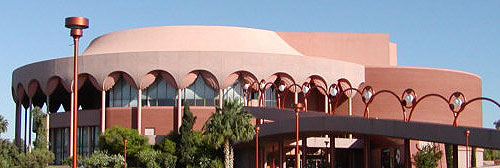- Introduction
- Brochure
- 3rd Ave/Indian
- 44/Camelback
- Walter Bimson
- Locations
- 3rd Ave Rehab
- Christown
- Competitors
- Wright
- Tempe Dome
- Los Arcos
- Research
- 16th St
- Safari
Banking on Progress:
The History and Future of the Valley National Bank Buildings in Phoenix
Walter Bimson and Frank Lloyd WrightWalter Bimson was a friend and supporter and near-client to Frank Lloyd Wright - nothing ever built, unfortunately. He hung out on those low-slung chairs at Taliesin. Some sources say Bimson was a patron of Wright's as early as 1942. In practical terms Bimson had an important role in the realization of the Grady Gammage auditorium at ASU - specifically, he and a fellow Chicagoan named Lewis Ruskin guaranteed the payment of Frank Lloyd Wright's fee and continued to push the project after Wright's death.
In more speculative terms, FLW's office designed a number of projects for Bimson, including an unusual proposed Usonian house, in textile block, in Phoenix (1954-57), and two unbuilt VNB branches, one meant for the once-genteel Sunnyslope (1948), and another designated for Tucson (1947) that could have served as a prototype. This is according to the book "Treasures of Taliesin" assembled by Bruce Brooks Pfeiffer out of the legendary and extensive Wright archives. In the presentation drawing the proposed Tucson VNB branch is like a faceted jewel in its setting, seen from one side, with overhangs. It was going to be a sort of open-air affair, open to the sunlight, Phoenician style. This was immediately after the war, before modern architecture hit the banking industry on the east coast, and even before Wenceslas Sarmiento re-designed the suburban bank on the west coast. At one point Wright wrote: "A bank should look like a strongbox, give a person a sense of security and protection for his money and valuables." The floorplan was a circle, with a hexagonal main floor with a mezzanine balcony and an open well looking into the basement, all lit from the overhead crystalline skylight. Downstairs were the vault, the safety deposit boxes and the bathrooms. And around back, along the curved back wall, were 6 drive-up (not drive-through) windows. This was the one design feature that Bimson and his board of directors absolutely rejected: a drive-up window. From Wright's perspective it fit right in with his vision of the American auto-centric 'Broadacre City', this low and loose urban form, a vision that would be proved correct. From VNB's perspective banking was a personal, social transaction and this wouldn't do. They wanted people to come inside the building. So that's the story of how Bimson missed a chance to revolutionize banking. He and Wright still both came out okay. In 1948, First Interstate Bank introduced the first drive-through bank in the valley, at 15th Street and McDowell.
|
- Introduction
- Brochure
- 3rd Ave/Indian
- 44/Camelback
- Walter Bimson
- Locations
- 3rd Ave Rehab
- Christown
- Competitors
- Wright
- Tempe Dome
- Los Arcos
- Research
- 16th St
- Safari
Banking on Progress:
The History and Future of the Valley National Bank Buildings in Phoenix
